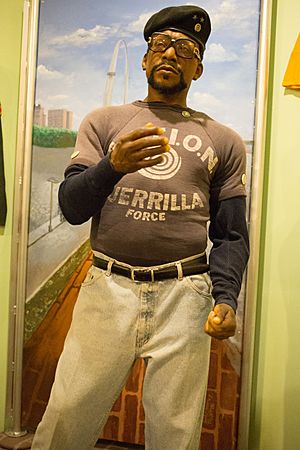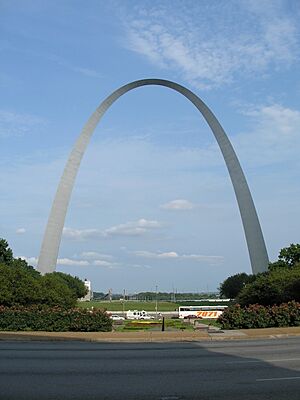Percy Green facts for kids
Quick facts for kids
Percy Green
|
|
|---|---|

Wax Figure of Percy Green at the Griot Museum of Black History
|
|
| Born | 1935 (age 90–91) St. Louis, Missouri
|
| Occupation | Engineer, Trade Unionist, Activist |
| Known for | McDonnell Douglas Corp. v. Green |
Percy Green II, born in St. Louis, Missouri, is a social worker and a Black activist. He has worked for equal rights in the St. Louis area for almost 50 years. He was a member of the Congress of Racial Equality (CORE). He also helped start ACTION (Action Committee to Improve Opportunities for Negroes).
Percy Green was involved in a very important civil rights case. It was called McDonnell Douglas Corp v. Green. This case is still often mentioned in American law today. He is also on the board of the Peace Economy Project.
Contents
Education and Early Life
Percy Green went to Toussaint L'Ouverture Elementary School. He also attended Vashon High School. Later, he studied at Washington University. From there, he earned a degree in social work.
Important Protests
Percy Green has been part of many important actions for Civil Rights. Two of the most famous protests happened in St. Louis. One was about building the Gateway Arch. The other was about the Veiled Prophet Ball.
Protesting the Gateway Arch
On July 14, 1964, Percy Green and a college student named Richard Daly climbed the Gateway Arch. They did this to protest that Black workers were not getting jobs. These jobs were part of the Arch's construction.
Green, Daly, and other protesters on the ground made a demand. They wanted the construction company to hire more Black workers. They asked for 10% Black workers within 10 days. This protest helped inspire the U.S. government. It led to the first major case against unfair hiring practices. This case was under the Title VII of the Civil Rights Act of 1964.
Today, a picture of Percy Green is inside the Arch. It is part of a display about the Arch's history.
McDonnell Douglas Corp. v. Green
Less than two months after climbing the Arch, Percy Green lost his job. He worked as a mechanic and lab technician at McDonnell Douglas Corporation. The company said it was because of money problems. But Green believed he was fired because he was Black.
This case eventually went to the Supreme Court. The Supreme Court decided in Green's favor. This decision was very important for discrimination law. It created a clear way to prove if discrimination happened.
Green's work with CORE and ACTION often focused on getting fair jobs. He protested companies like Wonder Bread and Southwestern Bell. He also targeted Laclede Gas Company and Union Electric (now Ameren UE).
Protesting the Veiled Prophet Ball
Percy Green and other ACTION members protested the Veiled Prophet Ball. This was a famous annual dance in St. Louis. It had been held every December since 1878. The ball was known for being very exclusive. Only certain elite families were invited.
By the 1960s, the ball was a target for Civil Rights protests. Jewish people and African Americans were not allowed to join. In December 1972, ACTION members went inside the ball. They worked with some debutantes who supported their cause.
Once inside, ACTION member Jane Sauer dropped flyers. This caused a distraction. Another member, Gina Scott, went behind the "Veiled Prophet." She pulled the mysterious hood from his head. Witnesses confirmed the Prophet was John K. Smith. He was a Vice President at Monsanto Corporation.
Green later said the group thought the organization was "racist, sexist & elitist." He felt that if the city wanted true equality, such an event should not exist. ACTION stopped its activities in 1985.
When Ellie Kemper spoke about her past involvement, Green shared his thoughts. He said that elite groups like the Veiled Prophet Ball should be ended. He felt they should not just try to include more diverse people.
Working for St. Louis City
Percy Green was later hired by the city of St. Louis. He directed a program for businesses owned by minorities and women. Under Mayor Freeman Bosley, Jr., Green made sure these businesses were truly owned by minorities or women. He prevented "front" businesses, where a white man secretly ran the company.
He kept this job under Mayor Clarence Harmon. However, his role became smaller. Green was let go by Mayor Francis Slay in 2001.
Congress of Racial Equality (CORE)
The Congress of Racial Equality (CORE) was a national civil rights group. It worked to end segregation using peaceful methods. The St. Louis chapter of CORE started in 1947. It included both Black and white members. These members were students, teachers, lawyers, and even World War II veterans.
Percy Green was a CORE member until 1964. At that time, he and 24 other members left the group. They wanted to keep doing direct action protests. There were disagreements about how to protest. Some wanted to continue civil disobedience. Others wanted to use new direct action tactics.
ACTION (1964-1984)
Percy Green was a founder of ACTION. This group was called the Action Committee to Improve Opportunities for Negroes. It started in 1964 and was active until 1984. ACTION worked to get better-paying jobs for African Americans. They protested companies like Laclede Gas, Union Electric, and Southwestern Bell. These companies are now known as Spire, Ameren, and AT&T.
Other Important Activism
In 1969, Percy Green and ACTION found churches that had ties to St. Louis utility companies. These companies were known for unfair hiring practices. ACTION used black paint to "blackwash" white statues of saints. This was a way to send a message.
In the summer of 1970, Green and ACTION members went into Southwestern Bell's main office. They brought molasses with them. The group poured molasses in the lobby. This was a "stick-in" protest. It meant the group would "stick" with the company until they changed their unfair practices.
Images for kids




